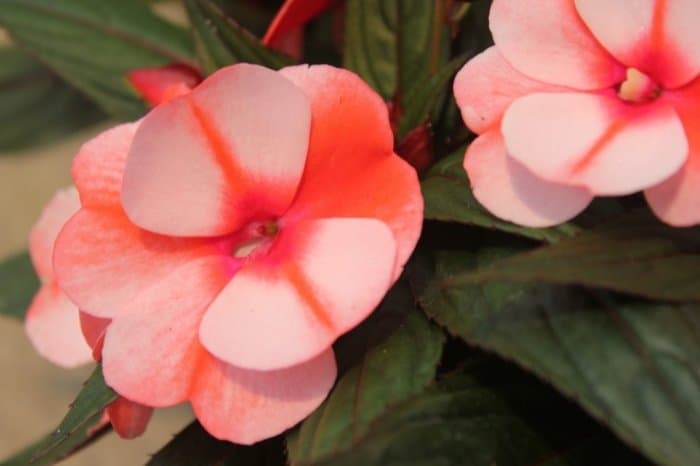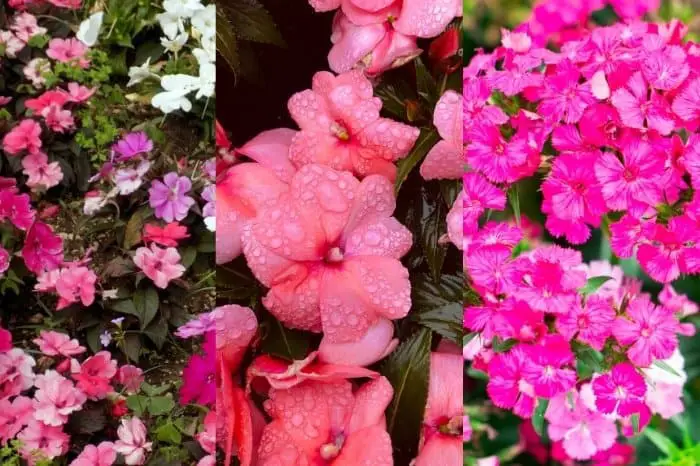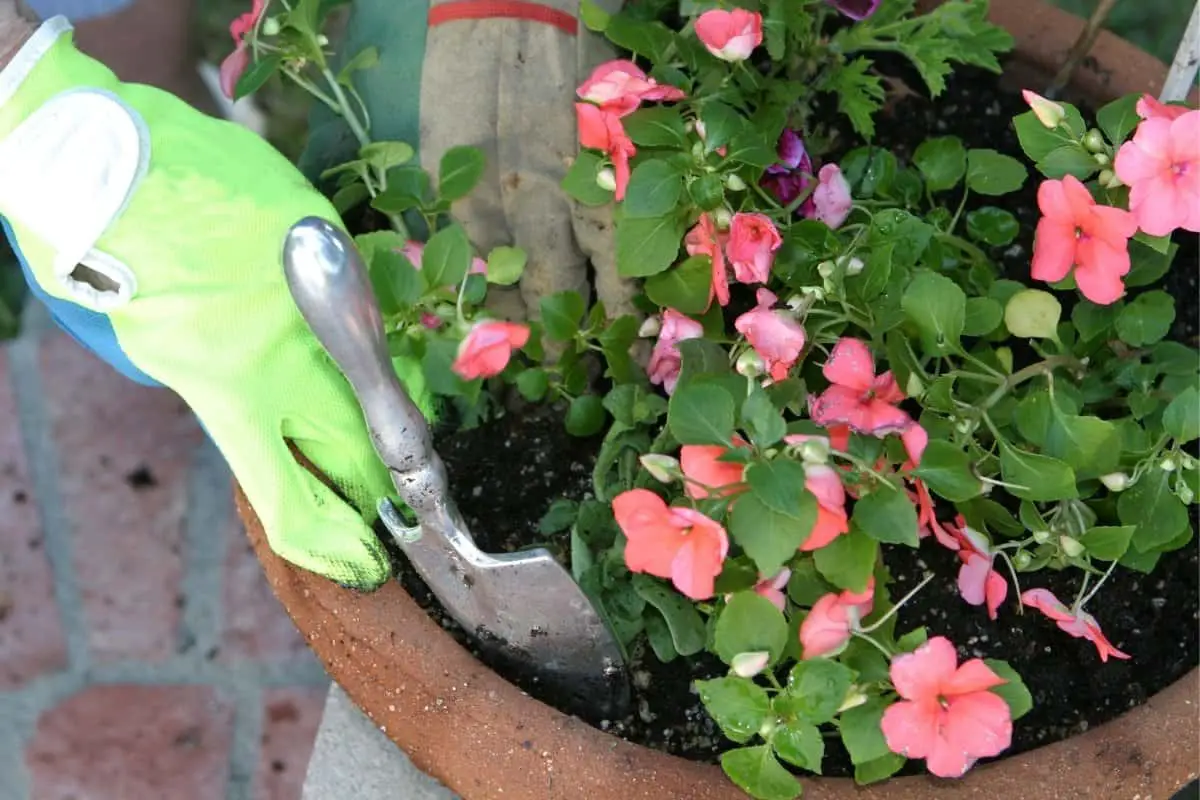Last Updated on November 11, 2021 by Cristina
You’ve done your research, you know which flowers thrive in the shade, but the main question persists – when to plant impatiens to get the best results? Picking the moment can either make or break your plans for a colorful summer garden. Proper care, suitable location, and season result in breathtaking blossoms. Let’s go through the crucial points of impatiens planting and sustaining.
Impatiens Flowers – The Effortless Star Of Your Garden
Impatiens are annual plants native to Africa, but you can find them in Eurasia and North America. The first impatiens are brought to North America somewhere between the 19th and 20th centuries. Since the 1960s, they’re cultivated to survive harsher conditions and can grow up to 30 inches.
The standard kind you can find in the US is Impatiens walleriana. It can even be a perennial plant in zone 10 and 11. They can be both house and outdoor plants, as long as you provide them with proper growing conditions.
You might be familiar with some types of impatiens as busy Lizzie, touch-me-not, snapweed, and patience.

When To Plant Impatiens
Planting impatiens at the right time will result in blooming bushes all summer long. They propagate easily from cutouts and even seeds, but you can also get them rooted from a garden center. Impatiens can thrive in a flower bed and pots, depending on your preference. However, they will require different care.
Check Out Do Deer Eat Impatiens? – Yes or No?
Best Location
Impatiens prefer partial or full shade. They’re ideal for bringing some color to the shady parts of your garden. If you don’t have much shade, don’t worry, there’s still something you can do. Get potted impatiens and expose them little by little to direct sun. Let them acclimate to these conditions slowly. Then, in a week or more, transfer them to their final place. This will build up their sun tolerance.
Directly exposing the impatiens to the sun will lead to withering and dying.
Ideal Season
Plant your impatiens in springtime, after the last frost. Make sure to check your local weather forecast. The lowest temperature they can survive is 32°F but thrive best at temperatures between 50°F and 70°F. Impatiens can endure up to 90°F but will require much more water.
Are Impatiens Biennial
You might find it surprising that impatiens are perennial. This is because they have no tolerance to frost, and there are just a few places that have a warm enough climate in the US. Therefore, if you plant them outside, their chances to survive the winter are meager. If you keep impatiens as houseplants, they have a great chance of flourishing as perennial flowers.
How Far Apart To Plant Impatiens
Depending on what look you’re aiming for, you can plant impatiens closer or further apart. If you want them to grow taller, plant the impatiens closer, no more than 6 inches apart. This encourages the stems to grow upwards.
If you’re looking to create a flower bed with impatiens, space them out 8 to 12 inches apart. This way, the flowers will lay low and spread out.
How To Make Impatiens Bushy
A bushy blooming impatience is a sight you’d love to see in your garden. Unfortunately, during midseason, the impatience might lose its glow due to many spent flowers. Take your scissors and cut the stems right below the spent flowers. This encourages new blooms.
If you can gather the courage, cut the whole plant leaving only 3 inches above the ground. It might seem drastic, but a new bushier impatiens will grow right back thicker than before.
Read more about How to Trim a Lilac Bush
Impatiens Flower Care: Do’s And Don’ts
Picking the right time to plant the impatiens is as essential as providing proper care later. These flowers don’t require much attention, so following just a few points helps you keep them fresh and radiant the whole summer.
- Impatiens require regular fertilization. It’s best to use a water-soluble fertilizer. Slow-release fertilizer works too, just use it once at the beginning of the season and again during midseason.
- They need good draining soil that’s rich in hummus. If you’re planting the impatiens outside directly into the ground, make sure to use some compost. If you’re using pots or containers, go for a soil-less mix that allows better drainage.
Flower Fuel 1-34-32, 250g – The Best Bloom Booster for Bigger, Heavier Harvests (250g)
- The number one rule for healthy impatiens is regular watering. Potted impatiens require daily watering, while grounded can do with once a week if you live in a place with low rainfall. During summer, when temperatures are high, you need to water them more frequently, up to twice a day. The impatiens wilt quickly when they lack water and lose their leaves.
- Don’t overwater the impatiens. This can lead to fungus growth and developing Impatience Downy Mildew.
Different Types Of Impatiens Flowers
Along with the most common type, there are also some rare impatiens kinds you can only find in certain areas of North America.
Impatiens capensis, known as jewelweed, has a characteristic color combo mimicking flames. It’s a wildflower that you can find in the forests of the east and the northern US. It requires deep shade and moist soil.
Impatiens pallida or Touch-Me-Not is native to US and Canada and blooms until late fall. It has yellow flowers and can grow up to 6 feet tall.
New Guinea impatiens or Impatiens hawkeri are not native to the US. However, a US expedition discovered them in 1969 while exploring New Guinea. This type has the highest tolerance to direct sunlight.
Impatiens balsamina or Rose balsam is the rarest type, native to South-East Asia. They’re annual and significantly smaller, growing up to 8 inches in height. Their flowers are cup-shaped, unlike other impatiens.

Bottom Line: When To Plant Impatiens
Impatiens are native to Africa, so naturally, they require a warm climate. It’s best to plant them in spring after all dangers of frost have gone. They make perfect flowerbeds and border plants. Provide a fully or partially shaded spot for them to thrive. Water and frequent fertilization are essential for a bushy, blooming plant.
You should always plant them in well-draining soil. Home plants can survive and be perennial, while outside flowers will die when temperatures drop below 32°F.
Do you have impatiens in your garden or home? Would you get your hands on a few roots this spring? Let me know in the comments below!
Mary is a passionate gardener who loves spending her days getting her hands dirty and nurturing her plants. She‘s an avid reader of gardening magazines and is always looking for new ways to make her garden thrive. When not outside tending to her plants, Mary can be found inside reading up on the latest gardening trends, comparing notes with fellow gardeners, and finding the perfect pottery planter for her next planting project.



